
Catalog excerpts

Go beyond what you thought possible with native MS * Thermo Scientific Q Exactive UHMR Hybrid Quadrupole-Orbitrap mass spectrometer Thermo Fisher SCIENTIFIC
Open the catalog to page 1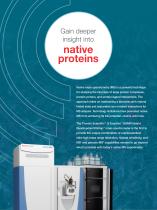
Gain deeper insight into native proteins Native mass spectrometry (MS) is a powerful technique for studying the structure of large protein complexes, protein-protein, and protein-ligand interactions. The approach relies on maintaining a biomolecule’s natural folded state and associated non-covalent interactions for MS analysis. Technology limitations have prevented native MS from achieving its full potential—that is until now. The Thermo Scientific™ Q Exactive™ UHMR Hybrid Quadrupole-Orbitrap™ mass spectrometer is the first to provide the unique combination of unprecedented ultra-high mass...
Open the catalog to page 2
“In the analysis of large protein assemblies like viruses, ribosomes, and proteasomes, the Q Exactive UHMR mass spectrometer has made things possible that we couldn’t do before. The major benefits of the system are the substantial increase in sensitivity and resolution that we get for very large protein assemblies, together with the ability to do MS/MS experiments.” — Professor Albert Heck, Utrecht University Confidently resolve small mass differences The Q Exactive UHMR mass spectrometer resolves the small differences in masses needed to characterize large and heterogeneous intact...
Open the catalog to page 3
Proven Q Exactive Hybrid Quadrupole-Orbitrap technology solves native MS challenges As analytes get larger and more complex, MS system capabilities need to advance to keep pace. Built on proven Thermo Scientific™ Q Exactive™ Hybrid Quadrupole-Orbitrap™ mass spectrometer technology, the Q Exactive UHMR mass spectrometer addresses the analytical challenges inherent to native MS. A combination of Orbitrap technology enhancements come together to allow direct detection of large, intact proteins and protein complexes with unprecedented resolution and orders of magnitude more sensitivity. “For...
Open the catalog to page 4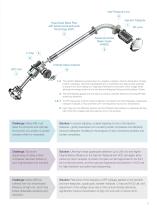
Injection Flatapole HyperQuad Mass Filter with Advanced Quadrupole Technology (AQT) Advanced Active Beam Guide (AABG) 3 Orbitrap Mass Analyzer HCD Cell 1, 2 The injection flatapole is pulsed down to a negative voltage to improve desolvation of large protein complexes, while the inter-flatapole lens is maintained at a high positive potential to prevent ions from eluting out. Trapping is followed by restoration of the voltage levels, allowing low-energy elution of ions into the bent flatapole (Advanced Active Beam Guide). 3 The bent flatapole guides and focuses ions using an axial DC field...
Open the catalog to page 5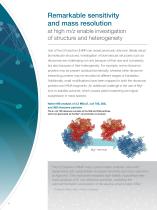
Remarkable sensitivity and mass resolution at high m/z enable investigation of structure and heterogeneity Use of the Q Exactive UHMR can reveal previously unknown details about biomolecular structures. Investigation of biomolecular structures such as ribosomes are challenging not only because of their size and complexity, but also because of their heterogeneity. For example, some ribosomal proteins may be present substoichiometrically, whereas other ribosomeinteracting proteins may be recruited at different stages of translation. Additionally, small modifications have been mapped to both...
Open the catalog to page 6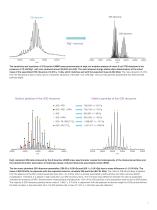
The sensitivity and resolution of Q Exactive UHMR mass spectrometer at high m/z enables analysis of intact E.coli 70S ribosome in the presence of 10 mM Mg2+ with ions centered around 36,000 m/z (left). The well-resolved charge states allow determination of the intact mass of the assembled 70S ribosome of 2,316 ± 1 kDa, which matches well with the expected mass (2,302 kDa). The mass deviation of 0.6% from the theoretical mass is mainly due to nonspecific adduction of the Mg2+ ions. With Mg2+ removal 70S particles disassemble into 30S and 50S particles (right). Distinct particles of the 30S...
Open the catalog to page 7
Ultra-high mass quadrupole selection and ultra-high mass range exceed previous limits The optimized Q Exactive UHMR instrument efficiently transmits and detects ions up to 80,000 m/z with unprecedented sensitivity. The spectra obtained are well resolved, allowing characterization of mixtures of protein particles, providing insights into their composition, ligand binding, and structure that are not easily obtained using other approaches. Native MS analysis of hepatitis B virus capsids under charge reducing conditions Mixtures of 3 MDa and 4 MDa hepatitis B virus capsids analyzed under charge...
Open the catalog to page 8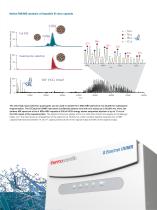
Native MS/MS analysis of hepatitis B virus capsids Relative Abundance Relative Abundance Relative Abundance Quadrupole selection The ultra-high mass selection quadrupole can be used to isolate the 4 MDa HBV particle at m/z 25,000 for subsequent fragmentation. The Q Exactive UHMR instrument confidently detects ions with m/z values up to 80,000 m/z. Here, the tandem MS spectrum of the 4 MDa HBV capsids at 300 eV HCD energy shows sequential ejection of up to 17 out of the 240 copies of the capsid protein. The ejected monomers appear at low m/z while the product ions appear at increasingly...
Open the catalog to page 9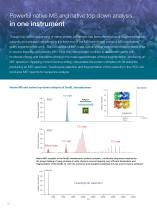
Powerful native MS and native top-down analysis, in one instrument Though top-down sequencing of native protein complexes has been reported, poor fragmentation into subunits and stripped complexes in the front end of the MS have limited previous MS instruments’ ability to perform this work. The Q Exactive UHMR mass spectrometer overcomes these limitations via in-source trapping and pseudo-MS3. First, the intact protein complex is desolvated gently with moderate energy and transferred through the mass spectrometer without fragmentation, producing an MS1 spectrum. Applying more in-source...
Open the catalog to page 10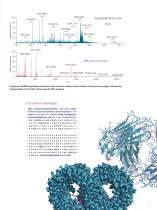
Exactive UHMR quadrupole selection of the monomer (shown at the bottom of the previous page), followed by fragmentation in the HCD cell for pseudo-MS3 analysis. @A k d]vlk)f!g!n!d1a]r!v)k!m l rIg v n]v l)a!d!a lv k)vlt! l!g! p k]g r)n!vlv) l!d!k!s) f]g!a! p!t) i t!k IdIgIv s vl a rIeIi eIl eIoIkIf eInIm gIaIqImIvIkIe 1v1a1s1k1a1n1d1a1a1g dIg tIt t aIt vIlIaIq aIiIiIt ElG L iOaIvIa AGMNPMDlLKRG I D]KAVTA A V E E L KlAl Ll Si Vl P C S Dl S K A llA Q VlG T il S = ANSDETVGKLIAEAMDiKVGKEGVIT 7 V E dIg tglqde ldvvegmqfdrgyls Q ] EEATSDYDREKLQERVAKLAGGV 1 7 AVI KVGAATEVEMKEKKARVEDALH ° 0...
Open the catalog to page 11All Thermo Scientific catalogs and technical brochures
-
CryoStar NX50
2 Pages
-
MSC-Advantage BSC
54 Pages
-
Multifuge
58 Pages
-
Thermo Scientific Pico 17 / 21
52 Pages
-
CO2 Incubator HERAcell 150 i / 240 i
196 Pages
-
Revco® Blood Bank Refrigerators
37 Pages
-
Multidrop Combi nL
4 Pages
-
Forma Environmental Chambers
25 Pages
-
MaxQ 6000
40 Pages
-
Multi Tube Rotator
13 Pages
-
picoSpin Spectrometer
6 Pages
-
1300 Series A2
76 Pages
-
CO2 Incubator Family
28 Pages
-
CO2 incubators
7 Pages
-
MaxQ Mini 4450 Shaker
40 Pages
-
E1-ClipTip Electronic Pipette
108 Pages
-
Varioskan™ LUX
54 Pages
-
ISQ Series Mass Spectrometers
412 Pages
-
Q Exactive™ BioPharma
16 Pages
-
Q Exactive Plus
4 Pages
-
LTQ XL™
4 Pages
-
Platinum DNA polymerases
6 Pages
-
-80°C Benchtop Freezer
2 Pages
-
Nicolet iS10 FT-IR Spectrometer
12 Pages
-
Ion S5 and Ion S5 XL Systems
2 Pages
-
SureTect Range
4 Pages
-
QuantStudio™ 3
8 Pages
-
Furnaces
2 Pages
-
Nunc Serological Pipettes
3 Pages
-
Nunc Cell Factory systems
8 Pages
-
Vanquish Duo UHPLC System [ZH]
12 Pages
-
Compound Discoverer Software
12 Pages
-
Vanquish Horizon UHPLC System
16 Pages
-
Thermo Scientific TSQ Duo
9 Pages
-
Thermo Scientific TSQ 8000 Evo
16 Pages
-
Heraeus Labofuge 300
2 Pages
-
Heraeus Cryofuge 5500i
8 Pages
-
Heraeus Clinifuge Centrifuge
2 Pages
-
Vials and Closures Catalog 2014-2015
128 Pages
-
RM 200 EG
4 Pages
-
Darwin LIMS
2 Pages
-
Immunohistory Solutions
292 Pages
-
Process Water Products Catalog
68 Pages
-
Technical Training Catalog
15 Pages
-
FBS Alternatives
8 Pages
-
Pierce Magnetic Beads
16 Pages
-
interactive catalog today
222 Pages
-
HERAGUARD HPH clean benches
2 Pages
-
MBC 240 Bench Top Analyzer
4 Pages
-
Konelab 20
2 Pages
-
Indiko
6 Pages



























































































![ISQ 7000 Single Quadrupole GC-MS System VPI [ZH]](https://img.medicalexpo.com/pdf/repository_me/78678/isq-7000-single-quadrupole-gc-ms-system-vpi-zh-191148_1mg.jpg)
![ISQ 7000 Single Quadrupole GC-MS System [ZH]](https://img.medicalexpo.com/pdf/repository_me/78678/isq-7000-single-quadrupole-gc-ms-system-zh-191147_1mg.jpg)
![Vanquish Duo UHPLC System [ZH]](https://img.medicalexpo.com/pdf/repository_me/78678/vanquish-duo-uhplc-system-zh-191145_1mg.jpg)





















































![Thermo Scientific Herasafe KS and KSP Class II Biological Safety Cabinets [EN]](https://img.medicalexpo.com/pdf/repository_me/78678/thermo-scientific-herasafe-ks-ksp-class-ii-biological-safety-cabinets-en-85081_1mg.jpg)











